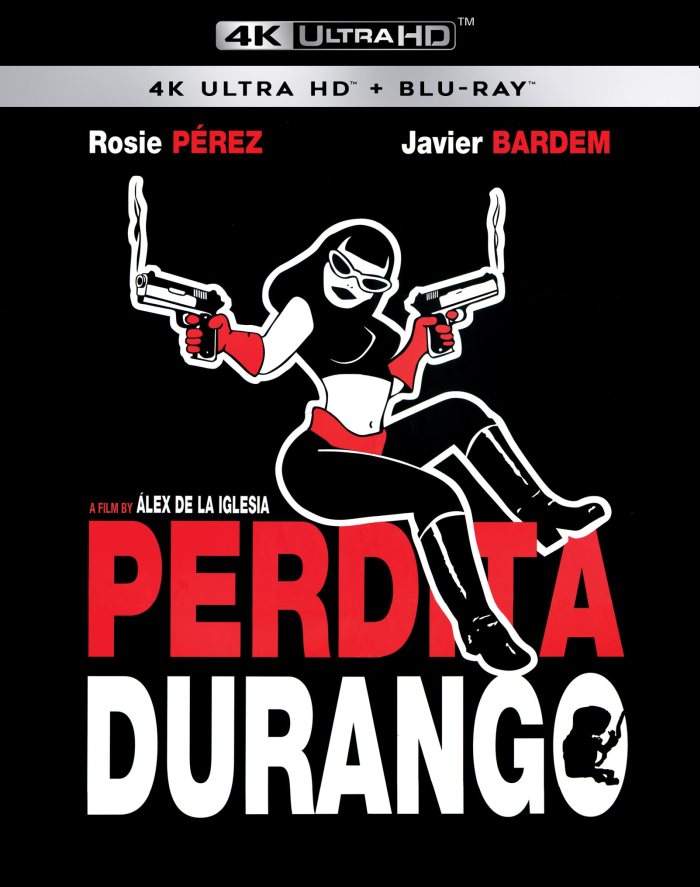
An important key to understanding Perdita Durango, the character: her boyfriend is a bank-robbing Santeria priest who, in front of a crowd, chops up dead bodies, throws their parts into a stew, drinks it, and spits it into his audience’s faces.
She thinks he’s getting a little boring.
They need to spice things up. So she wants to kidnap and murder some people for the next ritual. Some blondes. Romeo, the boyfriend in question, has an important drug deal to set up and an even more important assignment right after: he has to deliver a cargo of fetuses to Las Vegas where they will be turned into skin cream for the wealthy. But he’s still ready to kidnap some kids for his woman that night. Got to keep her happy.
These are the protagonists of Perdita Durango, Alex de le Iglesia’s English language debut from 1997. Rosie Perez plays Perdita as a ball of venomous anger, glaring at everyone with barely concealed contempt. Javier Bardem plays Romeo, an early venture into portraying a sociopath with weird haircut that he perfects in No Country for Old Men. That character was a force of nature, while Romeo is more human, and filled with a kind of thoughtful enthusiasm. That enthusiasm is, unfortunately, for evil.
Their kidnap victims are the two most milquetoast they can find, a couple of middle class kids out for a night on the town and who find a trip to hell. Perdita and Romeo kidnap them, tie them up, and mutually rape the youngsters before deciding which of them should be the star of the night’s show. The show ends up being botched, and so all four go on the road, trying to keep ahead of the cops and keep the rendezvous with that truck full of fetuses that has to get across the border.
The cops are represented by James Gandolfini’s Dumas, who pursues Perdita way out of his jurisdiction, despite being run over by cars more than once, attacked by an assassin, and barely surviving a shootout with Romeo and several criminal compatriots. It’s a testament to the power of Gandolfini’s charisma that he’s able to turn a character without depth or any real reason to do what he does into an engaging screen presence. He’s a cartoon spirit of vengeance. For what? Who knows.
Cartoon is an apt touchstone for the material, because despite having the outline of a gonzo crime story with maybe some horror elements, Perdita Durango is more like a comic book than a realistic movie. The characters are larger than life, and their world is a little brighter and weirder than the real world. Perdita and Romeo feel like they have leapt right from the pages of EC comics, while the rest of the story could be an early 90s Vertigo graphic novel.
The look of the film, which was filmed in the Southwest and in Mexico, is, for lack of a better word, extremely ’90s. Not in the sense of being “extreme” or a then contemporary MTV style editing scheme, but the colors are a little over saturated. The lighting is a little flat and bright, even in ostensibly dark scenes. Post Pulp Fiction, there were countless attempts to ape Quentin Tarantino’s style and story sensibilities, usually without his flair, grasp of cinematic language, or genuine humor. At first glance, Perdita Durango could look like one of these. The edgy plot and over the top scenarios could seem like a Tarantino copy with a misplaced sense of irony.
I don’t think that’s the right way to look at the film, though. Similar to the other recent de la Iglesia rerelease, Day of the Beast, Perdita Durango fully inhabits the moral universe of characters whose morality is completely skewed. Romeo believes his sincerity in his evil conveys a kind of nobility onto his actions. He’s genuinely disappointed when his kidnapees try to escape, rather than stick around to see how they play a part in his overall story.
The film is based on a novel by Barry Gifford, whose work was adapted by David Lynch in Wild at Heart. The Perdita character is even in that film, played by Isabella Rossellini. He also wrote Lynch’s Lost Highway and is credited on the screenplay for this film. His vision is of a twisted Americana where violence and debauchery are as much a part of the national myth as baseball and apple pie. Alex de la Iglesia’s world doesn’t entirely mesh with that vision, partially because Iglesia’s film seem to only tangentially take place in the real world.
Perdita Durango is entertaining, but not always entertaining enough. It deals with shocking material (besides the cannibalism, rape, and random murder, there’s some child molestation thrown in for fun) in a way that presents it a normal, in the view of its characters. But it could be funnier, it could be faster, and though the actual storyline isn’t complicated, it could be made clearer. It’s a deranged and creepy film, and a love story.
Perdita Durango has been released by Severin film on 4K Ultra HD and Blu-ray by Severin Films. The package includes two discs: the 4K UHD disc with just the film, and a Blu-ray which includes the film and all of the attendant extras. Video extras include “On the Border” (29 min), an interview with director Alex de la Iglesias; “Writing Perdita Durango” (17 min) an interview with Barry Gifford; “Dancing with the Devil” (13 min), an appraisal by film scholar Dr. Rebekah McKendry, “Narcosatanicos: Perdita Durango and the Matamoros Cult” (19 min), an interview with Abraham Castillo Flores and ‘Cauldron of Blood’ Author Jim Schutze about Perdita and Romeo’s real life inspirations, “Canciones de Amor Maldito: The Music of Perdita Durango” (21 min) with composer Simon Boswell, and “Shooting Perdita Durango” (5 min) an interview with DP Flavio Labiano. There’s also a pair of trailers.